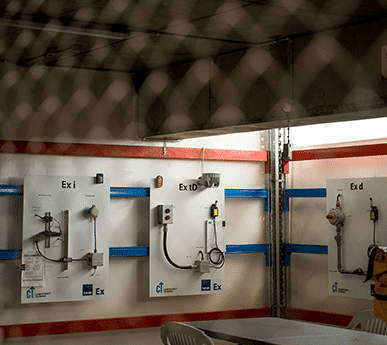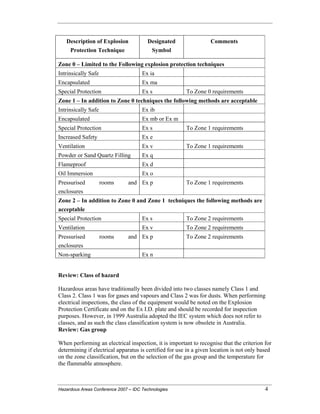Everything about Roar Solutions
Everything about Roar Solutions
Blog Article
A Biased View of Roar Solutions
Table of ContentsFacts About Roar Solutions UncoveredSome Known Incorrect Statements About Roar Solutions The smart Trick of Roar Solutions That Nobody is Talking About
In order to shield installations from a possible explosion a method of analysing and classifying a potentially unsafe location is called for. The purpose of this is to ensure the proper selection and setup of equipment to inevitably avoid an explosion and to ensure safety of life.
(https://www.cheaperseeker.com/u/roarsolutions)
No equipment must be set up where the surface area temperature level of the tools is above the ignition temperature level of the given danger. Below are some typical dust hazardous and their minimal ignition temperature level. Coal Dirt 380C 225C Polythene 420C (melts) Methyl Cellulose 420C 320C Starch 460C 435C Flour 490C 340C Sugar 490C 460C Grain Dust 510C 300C Phenolic Material 530C > 450C Aluminium 590C > 450C PVC 700C > 450C Residue 810C 570C The chance of the risk existing in a focus high adequate to trigger an ignition will differ from location to place.
In order to identify this threat an installation is separated into areas of risk depending upon the quantity of time the unsafe exists. These areas are described as Zones. For gases and vapours and dirts and fibers there are three areas. Area 0 Area 20 A hazardous atmosphere is very likely to be present and may be existing for extended periods of time (> 1000 hours per year) and even constantly Zone 1 Zone 21 A dangerous ambience is feasible yet unlikely to be existing for long durations of time (> 10 450 C [842 F] A classification of T6 implies the minimum ignition temperature level is > 85 C [185 F] Unsafe area electric devices possibly designed for usage in higher ambient temperature levels. This would suggested on the rating plate e.g. EExe II C T3 Ta + 60C( This indicates at 60C ambient T3 will certainly not be surpassed) T1 T1, T2, T3, T4, T5, T6 T2 T2, T3, T4, T5, T6 T3 T3, T4, T5, T6 T4 T4, T5, T6 T5 T5, T6 T6 T6 A T Course score of T1 indicates the maximum surface area temperature level generated by the instrument at 40 C is 450 C. Presuming the linked T Class and Temperature rating for the equipment are appropriate for the location, you can always utilize a tool with a much more rigorous Division score than needed for the area. There isn't a clear answer to this question however. It really does depend on the type of devices and what fixings require to be accomplished. Devices with particular test procedures that can not be carried out in the area in order to achieve/maintain 3rd party rating. Need to come back to the manufacturing facility if it is before the devices's service. Field Repair Work By Authorised Worker: Challenging screening might not be called for nonetheless specific procedures may need to be complied with in order for the tools to preserve its third event rating. Authorised employees must be employed to perform the work appropriately Repair work need to be a like for like replacement. New part should be considered as a direct replacement requiring no unique testing of the devices after the repair is total. Each tool with a hazardous ranking should be reviewed separately. These are outlined at a high level below, yet for more in-depth information, please refer straight to the guidelines.
7 Simple Techniques For Roar Solutions
The devices register is a thorough data source of devices documents that consists of a minimum set of fields to determine each product's location, technological specifications, Ex-spouse classification, age, and environmental data. This info is essential for monitoring and managing the tools properly within hazardous locations. In comparison, for periodic or RBI sampling assessments, the grade will be a mix of Detailed and Close examinations. The proportion of Detailed to Shut assessments will certainly be figured out by the Tools Threat, which is examined based upon ignition threat (the possibility of a resource of ignition versus the probability of a flammable atmosphere )and the harmful area category
( Zone 0, 1, or 2). This variation will certainly additionally affect the resourcing demands for job prep work. As soon as Whole lots are defined, you can create tasting plans based on the sample dimension of each Whole lot, which describes the variety of arbitrary devices products to be examined. To establish the required example dimension, two facets need to be examined: the size of the Whole lot and the category of assessment, which indicates the level of initiative that should be applied( lowered, typical, or increased )to the evaluation of the Lot. By integrating the category of examination with the Great deal size, you can then develop the suitable being rejected criteria for a sample, suggesting the permitted variety of faulty products found within that sample. For even more details on this procedure, please describe the Energy Institute Standards. The IEC 60079 standard suggests that the optimum period in between evaluations need to not go beyond 3 years. EEHA evaluations will additionally be conducted outside of RBI campaigns as part of set up maintenance and devices overhauls or repairs. These inspections can be attributed toward the RBI example sizes within the impacted Whole lots. EEHA evaluations are carried out to determine faults in electrical equipment. A weighted racking up system is crucial, as a single tool might have multiple mistakes, each with varying degrees of ignition danger. If the consolidated rating of both assessments is much less than two times the fault rating, the Great deal is deemed appropriate. If the Great deal is still considered inappropriate, it has to undertake a complete assessment or validation, which might cause stricter assessment methods. Accepted Great deal: The reasons for any mistakes are recognized. If a typical failure mode is found, added devices might call for maintenance. Mistakes are categorized by seriousness( Safety and security, Stability, Home cleaning ), making sure that immediate problems are assessed and addressed immediately to minimize any effect on safety and security or operations. The EEHA data source ought to track and record the lifecycle of mistakes together with the corrective activities taken. Applying a durable Risk-Based Examination( RBI )technique is important for making certain compliance and safety and security in handling Electric Devices in Hazardous Locations( EEHA) (hazardous area course). Automated Mistake Scoring and Lifecycle Administration: Effortlessly handle mistakes and track their lifecycle to boost evaluation accuracy. The intro of this support for risk-based examination additionally reinforces Inspectivity's placement as a best-in-class solution for governing conformity, in addition to for any kind of asset-centric assessment usage instance. If you are interested in discovering more, we welcome you to ask for a demonstration and uncover exactly how our option can transform your EEHA management procedures.
Roar Solutions Things To Know Before You Get This

In terms of eruptive risk, a hazardous location is a setting in which an eruptive environment exists (or might be expected to be existing) in quantities that call for special preventative measures for the building, setup and use devices. electrical refresher course. In this article we explore the obstacles faced in the work environment, the threat control actions, and the needed expertises to work safely
These websites materials can, in certain problems, create explosive ambiences and these can have significant and unfortunate consequences. Most of us are acquainted with the fire triangular get rid of any one of the 3 elements and the fire can not occur, but what does this mean in the context of unsafe locations?
In a lot of circumstances, we can do little concerning the levels of oxygen airborne, yet we can have significant influence on sources of ignition, as an example electrical equipment. Dangerous areas are recorded on the unsafe location classification illustration and are recognized on-site by the triangular "EX-SPOUSE" sign. Below, amongst other crucial information, areas are split right into three types depending upon the hazard, the probability and period that an eruptive atmosphere will certainly exist; Zone 0 or 20 is deemed the most dangerous and Zone 2 or 22 is deemed the least.
Report this page